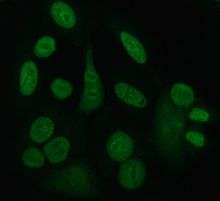Anti-SSA/Ro autoantibodies

Immunofluorescence pattern of SS-A and SS-B antibodies. Produced using serum from a patient on HEp-20-10 cells with a FITC conjugate.
Anti-SSA autoantibodies (Anti-Sjögren’s-syndrome-related antigen A, also called anti-Ro, or the combination anti-SSA/Ro or anti Ro/SSA autoantibodies) are anti-nuclear autoantibodies that are associated with many autoimmune diseases, such as systemic lupus erythematosus (SLE), SS/SLE overlap syndrome, subacute cutaneous LE (SCLE), neonatal lupus and primary biliary cirrhosis.[1] Also, they are often present in Sjögren's syndrome.[2] [3]
Presence of Anti-SSA/Ro in pregnant women with SLE is associated with an increased risk of neonatal lupus erythematosus in the child.[4]
Ro protein binds to Y RNA
Epidemiology
Approximately only 0.1 to 0.5 percent of the general population has the antibody.
References
- ↑ Franceschini, F.; Cavazzana, I. (2005). "Anti-Ro/SSA and La/SSB antibodies". Autoimmunity. 38 (1): 55–63. doi:10.1080/08916930400022954. PMID 15804706.
- ↑ Franceschini F, Cavazzana I (February 2005). "Anti-Ro/SSA and La/SSB antibodies". Autoimmunity. 38 (1): 55–63. doi:10.1080/08916930400022954. PMID 15804706.
- ↑ V Goëb; et al. (2007). "Clinical significance of autoantibodies recognizing Sjögren's syndrome A (SSA), SSB, calpastatin and alpha-fodrin in primary Sjögren's syndrome". Clin. Exp. Immunol. 148 (2): 281–7. doi:10.1111/j.1365-2249.2007.03337.x. PMC 1868868
 . PMID 17286756.
. PMID 17286756. - ↑ James, William; Berger, Timothy; Elston, Dirk (2005). Andrews' Diseases of the Skin: Clinical Dermatology. (10th ed.). Saunders. Page 160. ISBN 0-7216-2921-0.
This article is issued from Wikipedia - version of the 5/25/2016. The text is available under the Creative Commons Attribution/Share Alike but additional terms may apply for the media files.